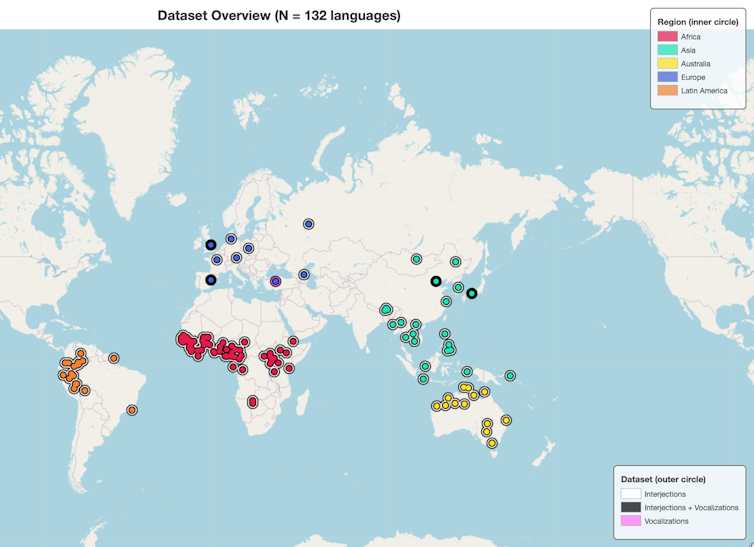Everybody is aware of what phrases we would shout out as soon as we stub a toe or contact one factor scorching. For these of us who talk English, it’s most probably “ouch”.
Nevertheless what types of “ache phrases” (or “interjections”) do audio system of various languages use to particular ache? And do these interjections attribute comparable sounds all through languages, as we would depend on in the event that they’re reflexive responses?
A model new article printed inside the Journal of the Acoustical Society of America examines this question for the first time. Our study measured vowels (“a”, “i”, “o”, and plenty of others.) in interjections expressing ache, disgust and pleasure in over 130 languages all through the globe. We then in distinction these with the vowels in nonlinguistic vocalisations (like moans, screams and plenty of others.) to examine whether or not or not interjections and vocalisations share comparable sounds.
Our outcomes suggest ache interjections can actually be traced once more to nonlinguistic vocalisations, nonetheless the story is way much less clear for pleasure and disgust.
What are interjections?
Interjections are standalone phrases that may be utilized on their very personal (like “ouch!” or “wow!”). They don’t combine grammatically with completely different phrases.
Because of linguists largely study grammatical mixtures, for a really very long time they didn’t pay quite a bit consideration to interjections. For that reason some very elementary questions on them have however to be answered – no matter interjections being very frequent in speech and fundamental to communication.
Ache, disgust and pleasure
The first purpose of our evaluation was to hunt out out whether or not or not interjections share comparable vowels all through languages based totally on the emotion or impact they’re meant to particular.
In that case, we wished to know whether or not or not these commonalities could also be outlined by the acoustic kinds of nonlinguistic vocalisations like cries and moans.
To examine this, we collected ache, disgust and pleasure interjections from dictionaries spanning many languages in Africa, Asia, Australia and Europe (better than 500 interjections in 131 languages).

Ponsonnet et al. (2024)
To match our interjections with noninterjection phrases, we used large databases with full lists of phrases for languages in our sample. This allowed us to run statistical checks to match the distribution of vowels in interjections to those current in numerous phrases.
These checks confirmed that on frequent, the ache interjections we collected have further “a” vowels, and further successions of vowels, like “ai” (as in “ay!” in Spanish) or “au” (as in “ouch!” in English). That is relevant all through the entire areas of the world we investigated.
To be clear, this end result doesn’t suggest all ache interjections will comprise an “a”, “ai” or “au” sound. Nevertheless while you select a random ache interjection, it has further prospects to have these sounds than while you select a random disgust or pleasure interjection, or another phrase.
Of the three types of affective experiences we checked out, ache was the one one with such properties. Vowels in disgust and pleasure interjections, towards this, did not differ markedly from completely different phrases.
This displays the vowels in ache interjections is not going to be random. So, the place do they arrive from?
Ache interjections resemble ache vocalisations
To find this question, we appeared on the nonlinguistic sounds people make to particular ache, along with disgust and pleasure.
We recorded lots of English, Japanese, Mandarin, Spanish and Turkish audio system producing vocal sounds – with out typical phrases – to particular these affective experiences. We then counted the vowels in these vocalisations.
We found each emotional experience has its private vowel profile for vocalisations: ache has further “a” vowels, disgust further central, “neutral” vowels (identical to the second vowel in “dragon”), and pleasure has further “i” vowels.
In several phrases, every interjections and nonlinguistic vocalisations for ache have further “a” vowels than anticipated. Nonetheless, disgust and pleasure interjections don’t share the similar vowels as a result of the vocalisations expressing these emotions.
What does it inform us?
Our study displays that whereas interjections are typical and language-specific, their vowels is not going to be completely random. Ache interjections have markedly further “a”, “ai” or “au” than anticipated. And with respect to “a”, they resemble nonlinguistic vocalisations.
This means that ache interjections may derive from the nonlinguistic sounds people produce when in ache, nonetheless this doesn’t look like the case for disgust and pleasure.
These outcomes clarify big questions regarding the origins of linguistic varieties. We continuously take into account phrases as arbitrary mixtures of sounds. The precise truth people say “residence” in English, nonetheless “casa” in Spanish, is normally thought-about purely typical.
Nevertheless some factors of language may be a lot much less arbitrary than others.
Ache – a central side of human experience – is said to sturdy physiological and emotional responses, to the aim that these spontaneous reactions may type the normal phrases individuals use to particular ache.
Rather a lot stays to be understood. On this study, we centered on vowels. Nevertheless this raises the question: what about consonants (“p”, “t”, “s”, and plenty of others.)“? And what about emotions except for ache, disgust and pleasure?
Such investigations will shed extra light on how embodied human language is, and the best way it developed initially in our ancestors.
